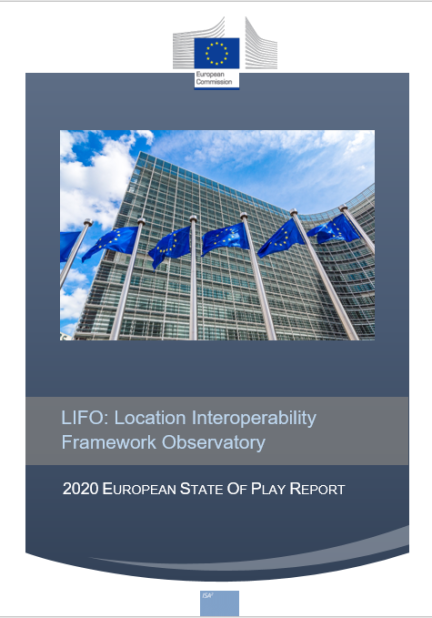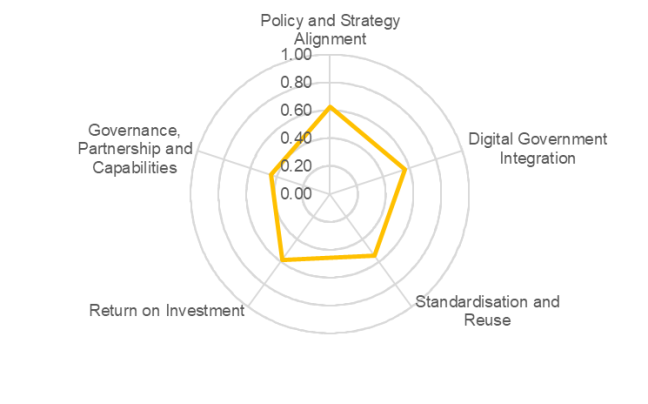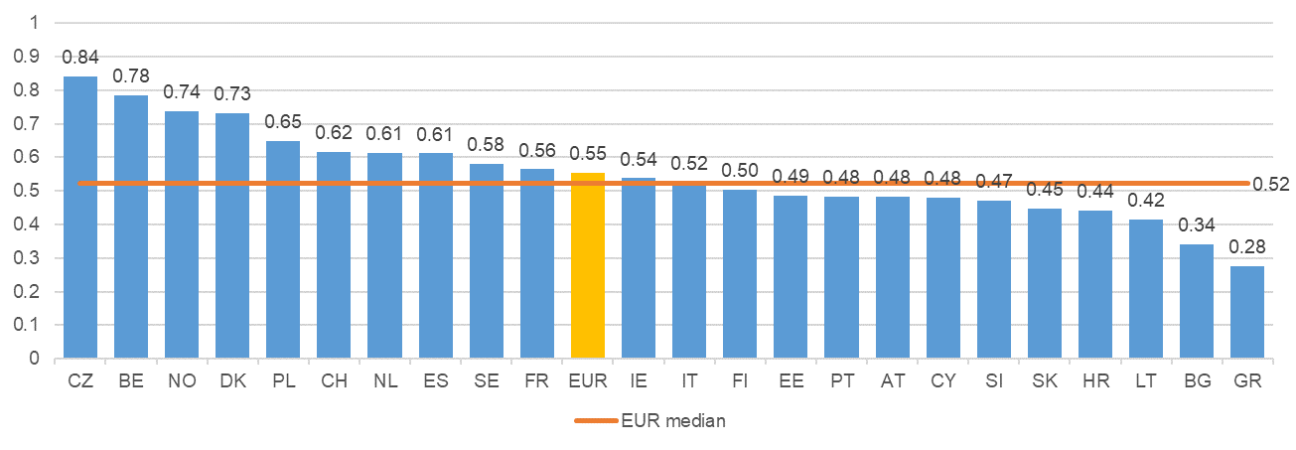



The Location Interoperability Framework Observatory (LIFO) is a domain-specific observatory relating to location interoperability. It provides a tool to monitor, assess and report on the state of play of location interoperability in policy and digital public services of EU Member States and other countries implementing INSPIRE.
This State of Play Report provides an overview of the information collected on location interoperability from 23 countries participating in 2020 (Austria, Belgium, Bulgaria, Croatia, Cyprus, Czech Republic, Denmark, Estonia, Finland, France, Greece, Ireland, Italy, Lithuania, Netherlands, Norway, Poland, Portugal, Slovakia, Slovenia, Spain, Sweden and Switzerland.
The combined LIFO index for the 23 countries is 0.55, which confirms an average good level of maturity for the participants.
The Policy and Strategy Alignment focus area has the highest score of 0.63, followed by Return on Investment (0.58), Digital Government Integration (0.57) and Standardisation and Reuse (0.55); the Governance, Partnerships and Capabilities focus area stands apart with the lowest score (0.45).
A group of four outliers (Czech Republic, Belgium, Norway and Denmark) have reported excellent scores in all focus areas; five more countries (Poland, Switzerland, The Netherlands, Spain, France and Sweden) are positioned above the average; the remaining countries (more than half of the total) have more or less significant room for improvement.
Even with the diverse levels of maturity across all focus areas, and in each of them separately, all countries have offered some examples of best practices in one or more focus areas.
The participating countries have focused on the strategic development of location interoperability (Policy and Strategy Alignment) by implementing location information strategies that are, to a certain extent, aligned with their digital strategies and, more broadly, with the relevant EU policy context. Most location data is available free of charge under an open licence (without restrictions or with minimum restrictions). In most countries, the use in digital government of authoritative location datasets and services is mandated by legislation or binding agreements. Most organisations are fully prepared and aware of location privacy aspects. Location underpins policy making in a good number of policy areas. Public procurements of location information and services refer more or less specifically to some form of relevant standard to identify the procured components correctly and indicate where they fit in an overall architecture of the Spatial Data Infrastructure (SDI).
SDIs underpin cross-government digital services to a good extent (Digital Government Integration focus area). Datasets and services conformant to the INSPIRE Directive are used for cross-border digital services, but not for domestic cross-government digital services, where data and services from the national SDIs (or even sector-specific SDIs) are more used. The public sector SDI is also sometimes exploited by non-governmental actors to develop and deliver their products and services. In general, location information is used to develop and deliver digital public services, but often in a basic rather than an innovative way.
Results in the Standardisation and Reuse focus area confirm that all participating countries consistently use standards to develop a comprehensive approach for spatial data modelling, sharing, and exchange to facilitate integration in digital public services. Reuse of generic solutions and of authentic data is promoted. Still, only a few authentic data registers have been implemented in several countries. Architectural and, most of all, data quality standards are less mature than the other practices in this focus area.
Under the Return on Investment focus area, the good results obtained confirm the attention paid to the sustainability of investments in the SDI. The advantages of exploiting location information are stressed, and the use of public sector location information is facilitated in several ways. However, assessing the efficiency and effectiveness of location-enabled digital services should be more fully considered to guide the necessary investments.
Finally, the Governance, Partnerships and Capabilities focus area is the weakest of the five. Capacity building and awareness-raising are still based on a limited catalogue of rather traditional options. Partnerships with cross-border organisations and with the private sector are rare, although they are more frequently adopted between public organisations in the participating countries. Organisations respectively coordinating the SDI and digital government in each country collaborate to a reasonable extent in the decision making on the role of the SDI in digital government, but other relevant stakeholders are involved only to a limited extent.


The European average LIFO index, summarising the overall EULF Blueprint implementation and therefore measuring the location interoperability maturity, has passed from 0.54 in 2019 to 0.55 in 2020 for the whole group of 23 participating countries, and to 0.60 for the subset of 10 countries having participated in both years.
The countries participating in both years have improved their positioning in all five focus areas. The improvements range from quite considerable in the Policy and Strategy Alignment focus area to only marginal in the Digital Government Integration focus area, but the overall difference is significant, also considering the other three focus areas.
Looking at the full group of 2020 participants, the upward trend has been less sharp: there still have been improvements in the Policy and Strategy Alignment and, to a lesser extent, in the Digital Government Integration focus areas, but the other three areas have remained at almost the same scores as 2019. This means that, on average, the progress registered in the 10 countries participating in both years has been offset by the lower average scores of the new participating countries.
For more details, download the State of Play report here below in the attachment section.
Click here to explore the LIFO 2020 and 2019 results in the LIFO Interactive Dashboards.
Click here to to find out more about the Location Interoperability Framework Observatory (LIFO).